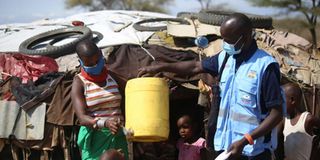Premium
The nightmare of manyattas serving as isolation centres

Community health volunteer Andrew Lekutar sensitises Lemeishoda and her children on Covid-19 preventive measures at Mabatini village, Archers Post on August 19.
What you need to know:
- In Samburu, functional quarantine centres are scarce.
- Patients self-isolate in their manyattas, which lack basic health facilities to manage the deadly virus.
The Covid-19 pandemic has exposed the sorry state of health infrastructure in rural counties. A majority of governors claimed they had put in place measures to handle the pandemic, but things are different on the ground. Patients are going through hell to stay alive.
In Samburu, functional quarantine centres are scarce. Patients self-isolate in their manyattas, which lack basic health facilities to manage the deadly virus. In Shabaa area, these manyattas — made of mud, cow dung and plastic bags — act as quarantine centres for a population that is yet to embrace modernism.
As pastoralists, the Samburus are constantly on the move in search of water and pasture for their livestock. They are also polygamists. In some cases, they share the temporary structures with their animals.
Samburu was the last county to register a Covid-19 case. But in two weeks, they moved from one to 40 cases. Of these, just one is in the isolation centre at the county referral hospital in Maralal town.
The Nation has established that the isolation centres in Wamba and Baragoi are empty as most asymptomatic patients are under home-based care. A patient in Shabaa spoke of the dire situation in the villages, where social distancing is an alien culture.
Sharing space
“We always mingle with each other because there is nothing much we can do about it. So far, I haven’t developed any symptoms. I feel okay and energetic. I was tested about a week ago. I am in my manyatta doing my things,” he offered.
The Ministry of Health’s home-based care guidelines stipulate that there is a separate bedroom or isolation space where the patient can recover without sharing immediate space with others. But this is impossible in manyattas.
For pastoralists, these guidelines are difficult to follow. Personal protective equipment such as face masks and gloves do not exist here. Water, which is crucial in observing basic hygiene, remains scarce, more than 40 years after independence. Locals have to trek for up to 14 kilometres to fetch just 20 litres of the precious commodity.
Samburu Health Executive Stephen Lekupe said all cases in the county are asymptomatic, which are ideal for home-based care.
“It’s better to keep them home until they develop symptoms. It’s been a challenge because of the cultural practices of the Samburus. We are doing our best to ensure the cases do not multiply,” he said, adding that the county will be setting up an isolation centre for asymptomatic patients at the Maralal Polytechnic.
“It is difficult to contain the disease in a nomadic set-up, but we are trying as much as we can. The poor conditions in manyattas are also contributing to the surge in infections,” he added.
Patients with mild symptoms are advised to disinfect all house surfaces, and have dedicated linen and designated cutlery, which is impossible with pastoralists, who use traditional mats made from animal skin.
Cost of treatment
Acting Health Director-General Patrick Amoth recently said asymptomatic patients will remain under home-based care because of the high cost of treatment. “We came up with home-based care protocol because the responsibility of Covid-19 management lies with the individual,” he said. “Let us observe the measures to avoid the hospitalisation route.” Daily treatment of an asymptomatic patient costs an average of Sh21,000 and Sh21,400 for one with mild symptoms.
Those with severe Covid-19 and require supplemental oxygen fork out Sh51,000 while critically ill patients who need ICU or ventilators pay an average of Sh71,000.
Apart from the threat of asymptomatic patients spreading the virus in their clusters, contact tracing is also poor in Samburu as families are constantly on the move.





